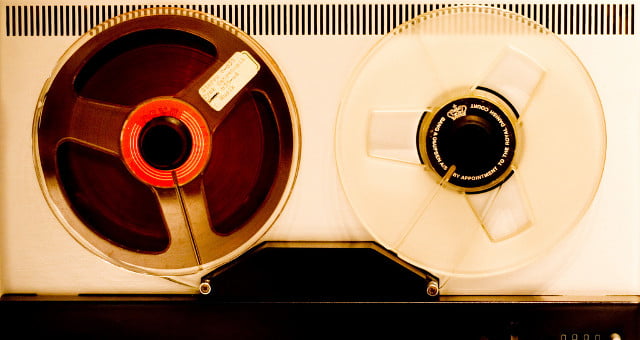
Is it possible to speak with the dead? In the 1960s, Latvian parapsychologist Konstantīns Raudive investigated electronic voice phenomena, embarking on a journey that would seem to have answered that question.
He recorded over 100,000 audiotapes and shared his experiences in a book published in 1968 titled Unhörbares wird hörbar (The Inaudible Becomes Audible), later translated to English in 1971 as Breakthrough: An Amazing Experiment in Electronic Communication with the Dead.
Inside this book — in this case a small, gray hardcover — are many strange and remarkable claims.
The bulk of it consists mostly of transcripts, conversations Raudive purports to have had with the deceased using his various recording methods. Whether you choose to believe it or not, here’s some of what Breakthrough tells us.
Methods of Recording
The English-translated version of Breakthrough actually begins with a preface by Peter Bander. In it, he tells the story of how the book came to be published in English, and how he met Raudive for a demonstration of his recording methods. The book goes into more detail, but suffice it to say, these were the three primary methods of recording used during the experiments:
- Microphone: Simply recording with a microphone, as you’d record anything else
- Radio: Recording the “inter-frequency” or white noise of a radio, sometimes directly, other times with a microphone
- Diode: Recording with a diode — “a piece of germanium with a bit of metal on it” — which is less sensitive than a radio
In any case, Breakthrough puts forward the claim that, using these three recording methods and playing them back, you may hear the voices of the dead, and even converse with them.
Characteristics of Speech

And this is where things get interesting.
When you think of Electronic Voice Phenomena (EVP), you may believe it’s a simple matter of asking a question, recording the silence, and possibly getting a response. And it is. At this point, discussing EVP is far from novel. But Konstantīns Raudive’s research is a bit more compelling than you may expect.
After all, if these are ghosts or spirits outside of their physical bodies (by our definition), how are they able to speak? How are they able to physically form words and sentences into something we can hear? Raudive’s book explores this issue of audibility particularly in-depth, describing the “troubles” one might encounter while attempting to communicate with incorporeal beings.
The first issue is the speech itself. Raudive describes it as rapid, with a “definite rhythm” that makes it seem like the speaker is being forced to talk quickly, due to how strenuous or unnatural the process is. The voices also have a different pitch and volume from normal human voices.
Due to these peculiar differences, he writes, “the verification of the voices depends on repetition, and the ear cannot hear the voices without technical aids.”
The second issue comes from the voices’ unpredictable use of language, which Raudive describes as “their own language — a kind of Esperanto, a single sentence often comprising a number of languages and cut down to the barest essentials.”
The voices use a mix of different languages, and often do not abide by grammatical rules (in the book’s preface, Bander raises the possibility that this may have to do with the experimenter’s own bias, as Raudive himself spoke many languages). Raudive describes the odd way the voices speak as often “telegram-style.”
It may take many months, he says, to learn how to interpret these voices and their unique speech patterns.
Deliberate Contact
Now, the question of whether or not audible voices exist in a recording is one thing. That these voices belong to actual spirits — deliberately contacting us from beyond — is another.
One of the more obvious explanations for this phenomenon raised in the book is radio interference. It’s always possible that, when recording static (particularly when using the radio method), you may accidentally pick up errant signals from nearby radio stations.
There are also the issues of “priming” — when the listener hears what he or she expects to hear — and human error. In general, most view EVP as a very dubious form of paranormal research.
However, Raudive doesn’t believe this is the case with his own research, because the voices seem to respond to questions. They also tend to name people in the room where the recording is taking place.
“Open the door”
The conversations Raudive shares in Breakthrough, if we are to believe them, point toward these voices being intelligent. Even in the preface, Bander describes his own encounter with these so-called voices from space.
He was in the process of deciding whether or not to publish the English translation of Breakthrough, when he found himself listening to alleged recordings of spirits. At first, he heard nothing. But then — a voice in German, “Mach die Tür mal auf” or “Why don’t you open the door?” This took him by surprise, because despite its rapid and peculiar speech, he found it very familiar. It was, he claimed, his mother’s voice.
Needless to say, after meeting with Raudive and having the various methods of spirit recording demonstrated to him (not without some issues, of course), he decided to publish the translation.
“Imagine, I am!”
One of the more interesting forms of “deliberate contact” Raudive himself shares is that of Margarete Petrautzki. According to Raudive, in life, and even up until the very end, Petrautzki “maintained that she could not envisage an existence after death.”
And yet, he claims to have communicated with her spirit. “During one of his recording sessions,” he writes, “the experimenter asked her how she felt ‘over there’, and the answer — ‘Imagine, I am!’ — was spoken in a happily astonished tone of voice.”
You Are Sleeping, You Do Not Want To Believe

Breakthrough raises many questions. Without having watched the process myself, or performed any voice experiments of my own, for now it remains just a curious little book. However, it did originally come with a 7-inch record of voice samples, and the audio is out there (an mp3 version is also available on Amazon). You can, then, make your own determination.
The hardcover itself seems to be out of print (though you may be able to order directly from the publisher), and used prices have skyrocketed since I tracked down my copy. WorldITC, however, appears to have an excerpt of Chapter One available.
At any rate, if we take Raudive’s findings at face-value, I suppose the question becomes a little different from the one I asked before: If you could speak with the dead, would you? Given that the methodology is laid out right in the book, there’s no reason you can’t try it for yourself. I just might.
// I have a lot more to say about Raudive’s experiments and spirit communication in general, but we can get to that later. It’s funny, though — I’d always wondered where the sample used at the end of The Smiths’ song “Rubber Ring” came from. Now I know.






